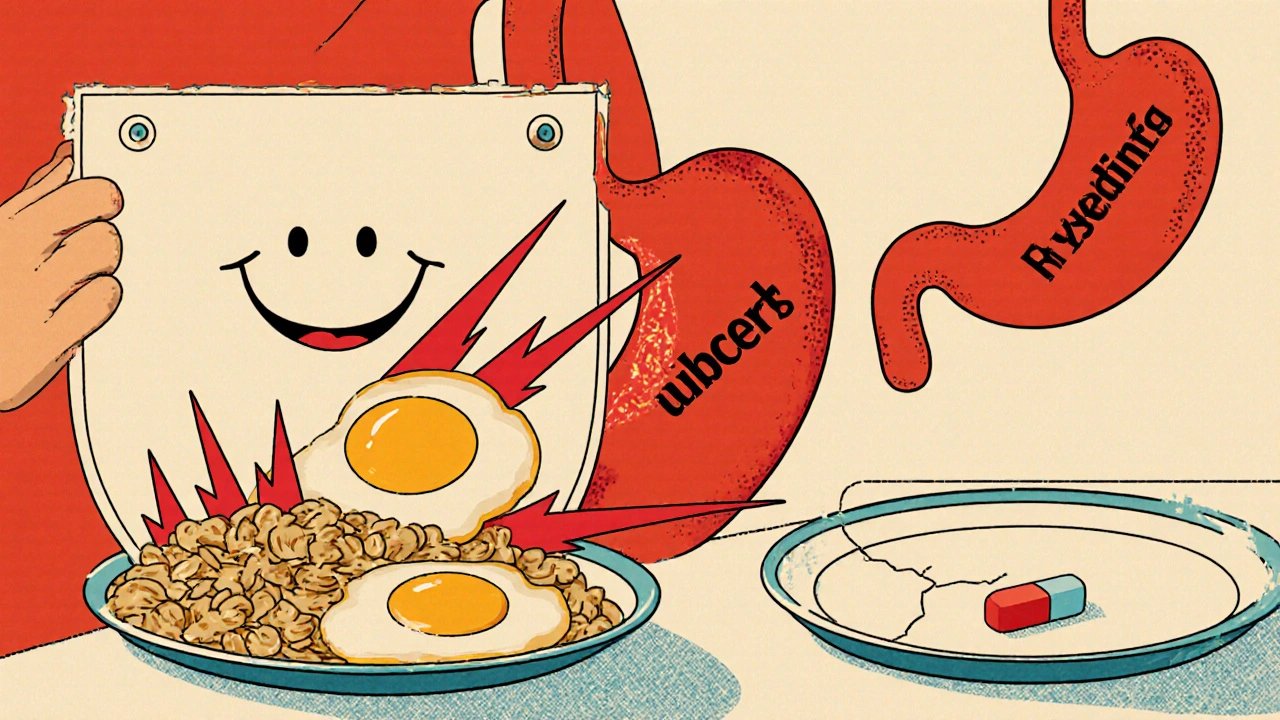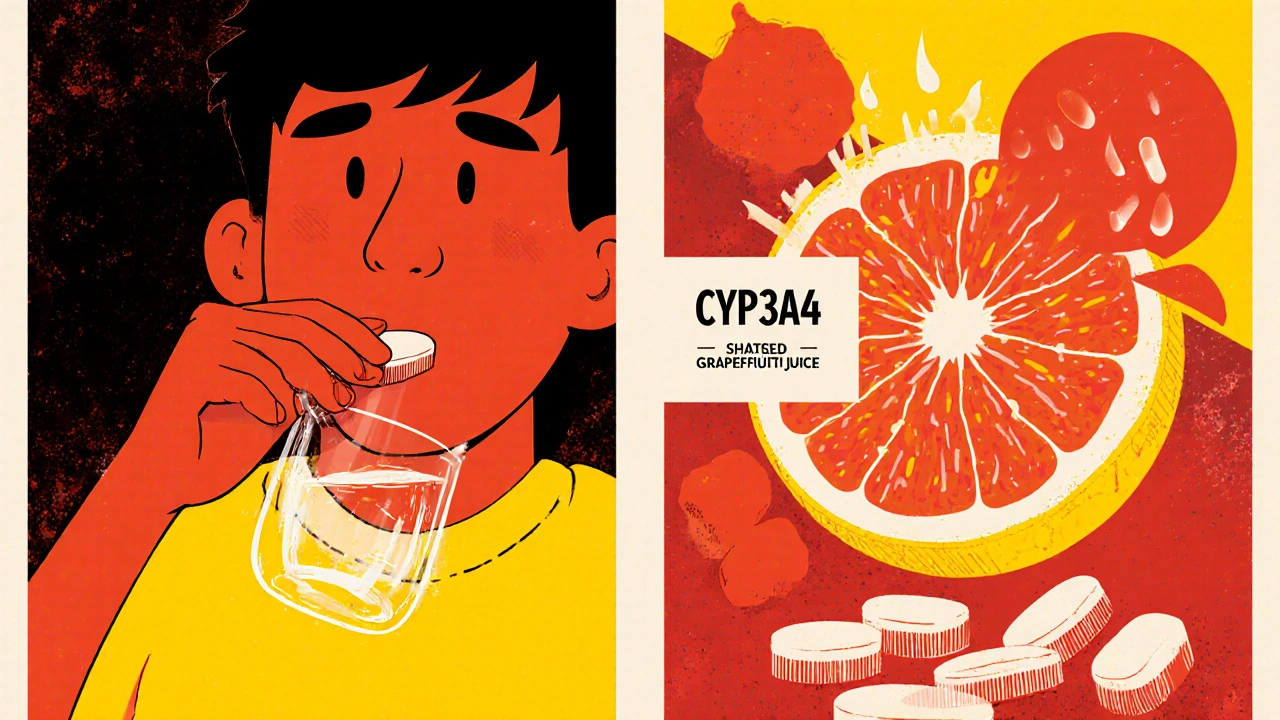Medication-Food Interaction Checker
Check if your medication interacts with common foods. Based on FDA guidelines and medical research.
Select medication and food to see interaction details
Most people don’t think twice about swallowing a pill with a glass of water. But what if that glass of water was a cup of coffee, a bowl of oatmeal, or a glass of grapefruit juice? The truth is, what you eat when you take your medication can make the difference between a safe, effective dose and a dangerous reaction. It’s not just about getting better-it’s about avoiding hospital visits, stomach ulcers, or worse.
Why Food Changes How Medicines Work
Your digestive system isn’t just a pipe for food. It’s a complex chemical factory that affects how drugs enter your bloodstream. When you eat, your stomach slows down, your pH shifts, and enzymes kick into gear. These changes can either help a drug work better-or block it completely.
For example, some antibiotics like ciprofloxacin bind to calcium in dairy products, cutting absorption by up to 50%. That means the drug never reaches the infection. On the flip side, drugs like griseofulvin, used for fungal infections, absorb 15-30% better when taken with a high-fat meal. Food literally pulls the medicine into your system more efficiently.
Food also protects your stomach. Nonsteroidal anti-inflammatory drugs (NSAIDs) like ibuprofen and naproxen irritate the stomach lining. Studies show that 38% of people who take them on an empty stomach develop microscopic bleeding in their gut. That number drops to 12% when taken with food. It’s not just about avoiding heartburn-it’s about preventing internal damage you can’t even feel.
When Food Makes Medicines Dangerous
Not all food-drug interactions are helpful. Some are life-threatening.
Grapefruit juice is the classic example. It blocks an enzyme called CYP3A4 in your intestines-the same enzyme that breaks down dozens of medications. When that enzyme is shut down, drugs like cyclosporine, simvastatin, and certain blood pressure pills build up to toxic levels. One glass of grapefruit juice can do this for up to 72 hours. That’s why some patients end up in the ER after eating a grapefruit with their morning pills.
Warfarin, a blood thinner, is another high-risk case. It’s sensitive to vitamin K, which is found in leafy greens like spinach and kale. If you normally eat a salad every day and suddenly skip it, your blood can clot dangerously. If you start eating five servings of kale a day, you could bleed out. Consistency matters more than avoiding the food entirely.
Even common supplements can cause trouble. Calcium, iron, and magnesium in multivitamins or antacids can bind to thyroid meds like levothyroxine, cutting absorption by up to 55%. That means your body doesn’t get the hormone it needs-leading to fatigue, weight gain, and heart problems.
Which Medicines Need Food? Which Need an Empty Stomach?
There’s no one-size-fits-all rule. The instructions depend entirely on the drug. Here’s what the data shows:
- Take with food: NSAIDs (ibuprofen, naproxen), antibiotics like doxycycline, antifungals (griseofulvin), statins like simvastatin, antipsychotics like clozapine, and diabetes drugs like metformin. Food reduces nausea, vomiting, and stomach damage.
- Take on empty stomach: Levothyroxine (thyroid), bisphosphonates (osteoporosis), antibiotics like amoxicillin and tetracycline, and some HIV meds. Food blocks absorption.
- Flexible timing: Many antidepressants, blood pressure pills, and cholesterol drugs. Food might slightly change absorption but doesn’t affect safety or effectiveness.
The FDA now requires food-effect studies for nearly 80% of new drugs approved since 2018. That means your doctor or pharmacist should know whether your pill needs food or not. But here’s the problem: only 22% of patients over 65 get clear instructions when their prescription is filled.

Real People, Real Mistakes
It’s not just theory. Real patients make these mistakes every day.
A Reddit thread with over 1,200 comments found that 78% of people taking methotrexate (used for rheumatoid arthritis and cancer) had less nausea when they took it with food. But 22% said their symptoms got worse-because food slowed absorption too much, making the drug less effective.
On Drugs.com, 63% of people taking metformin for diabetes said they had severe diarrhea or cramps when they took it without food. When they switched to taking it with meals, 80% reported major improvement.
One Cleveland Clinic survey found that 57% of people taking levothyroxine admitted to taking it with breakfast-often with coffee, milk, or cereal. As a result, 32% needed higher doses just to get their thyroid levels into the normal range. That’s not laziness-it’s lack of education.
And it’s not just older adults. Only 28% of people under 35 ever ask their pharmacist about food interactions. That’s a huge gap.
How to Get It Right Every Time
Here’s how to avoid the most common mistakes:
- Read the label. Look for phrases like “take on empty stomach” or “take with food.” If it’s not clear, ask.
- Use a food timing app. Apps like Medisafe let you set alerts for when to take each pill, with reminders like “Take with breakfast” or “Wait 2 hours after eating.” Clinical trials show these reduce errors by 37%.
- Keep a food-drug log. Write down what you ate and when you took your meds. If you notice side effects, you can spot the pattern.
- Ask your pharmacist. They’re trained to catch interactions. Don’t assume your doctor told you everything. Pharmacists review your full list of meds and can flag conflicts you didn’t know about.
- Don’t assume “with food” means “with a snack.” The FDA defines “with food” as at least 250-500 calories. A handful of almonds won’t cut it. You need a proper meal.
Many hospitals now use color-coded charts: green = take with food, red = take on empty stomach, yellow = flexible. You can ask your pharmacy for a similar chart to keep in your wallet.

The Bigger Picture: Why This Matters
Improper food-drug timing isn’t a minor issue. It’s a public health crisis.
68% of medication-related hospitalizations in the U.S. are linked to these kinds of mistakes. That costs the system $177 billion a year. And it’s preventable.
New tech is starting to help. In March 2024, the FDA approved Abilify MyCite-the first “smart pill” that tracks when you take it and whether you’ve eaten. Early results show a 32% drop in food-related side effects.
Companies like Nutrino and Vitagene now offer DNA-based reports that tell you how your genes affect how you process certain drugs with food. For $149-$299, you can get a personalized plan. But you don’t need a test to get it right. You just need to ask the right questions.
As processed foods become more common-and full of hidden additives, sugars, and fats-the risk of unpredictable interactions is rising. The American Gastroenterological Association warns that without better patient education, adverse events could increase by 15-20% in the next decade.
But here’s the good news: you have control. You don’t need to be a scientist. You just need to know your pills, know your meals, and never be afraid to ask.
Can I take my medication with coffee?
It depends. Coffee can interfere with some medications, especially thyroid drugs and certain antibiotics. It can also speed up stomach emptying, which reduces absorption. For most pills, water is the safest choice. If you’re unsure, wait at least 30 minutes after your coffee before taking your medicine.
What if I forget to take my pill with food?
If you realize right away, take it with a snack or meal. If it’s been more than an hour or two, check the label or call your pharmacist. For drugs like levothyroxine, waiting until the next dose is safer than doubling up. Never take two doses at once unless instructed.
Does it matter what time of day I take my medicine with food?
For most medications, timing matters less than consistency. But for some-like levothyroxine or blood pressure pills-taking them at the same time each day helps your body adjust. The key is to match your pill schedule to your meal schedule so you don’t have to remember extra rules.
Are over-the-counter drugs affected by food too?
Yes. Even aspirin, ibuprofen, and antacids can be affected. Taking ibuprofen on an empty stomach increases stomach bleeding risk. Antacids with calcium can block absorption of antibiotics like tetracycline. Always read the OTC label carefully.
Why don’t doctors always tell me about food interactions?
Doctors are often rushed. A typical visit lasts 15 minutes, and they may assume you read the label or that the pharmacist explained it. But studies show that only 22% of patients get clear food instructions during their prescription counseling. It’s up to you to ask: “Should I take this with food?”
What to Do Next
Start today. Grab your pill bottles. Look at the labels. Write down which ones say “take with food” and which say “take on empty stomach.” Make a simple list. Keep it on your fridge or in your phone.
Call your pharmacy. Ask them to review your full list of medications for food interactions. Most will do it for free.
Set a reminder on your phone: “Ask pharmacist about food with meds.”
Small steps prevent big problems. You don’t need to memorize every interaction. You just need to be curious, ask questions, and stick to a routine. Your body-and your wallet-will thank you.
